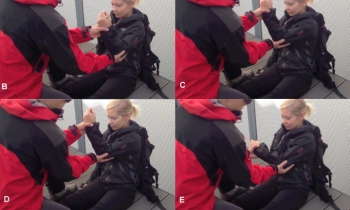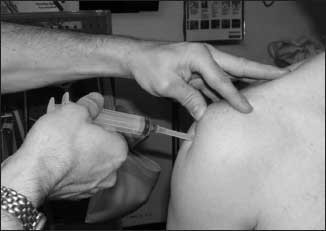19/05/2015
Luxation d'épaule: Une méthode simple ?
Reduction of Acute Shoulder Dislocations in a Remote Environment: A Prospective Multicenter Observational Study
Bokor-Billmann T. et Al. Wilderness Environ Med. 2015 Mar 27. pii: S1080-6032(15)00006
OBJECTIVE:
Acute dislocations of the glenohumeral joint are common in wilderness activities. Emergent reduction should take place at the site of trauma to reduce the patient's pain and the risk of vascular and neurological complications. A limited number of reduction methods are applicable in remote areas. The aim of this study is to present our method of reduction of anterior shoulder luxation that is easily applicable in remote areas without medication, adjuncts, and assistants and is well tolerated by patients.
METHODS:
A prospective observational study was conducted during a 5-year period. The patients included underwent closed manual reduction with our technique. After each reduction, the physician who performed the reduction completed a standardized detailed history, and reexamined the patient (for acute complications). The patients were contacted 6 months after the trauma to investigate long-term postreduction complications.
Diagram depicting the steps of our reduction procedure. The practitioner holds the patient’s wrist with the left hand (in the case of a left shoulder dislocation) and the patient’s elbow with the right hand.

(B) With the elbow in 90° of flexion, the glenohumeral joint is flexed forward to 90°. (C) While still in flexion, the glenohumeral joint is adducted until the elbow reaches the midline of the body; it is important to continue this movement until this landmark is completely reached. (D) Then, internal rotation of the shoulder is performed. During this step, the patient’s elbow must stay at the landmark described above. At 25° to 30° of rotation, a mild resistance is usually encountered. (E) The last step of the maneuver consists of applying a constant internal rotation pressure to overcome this mild resistance without pain. Reduction is usually achieved at approximately 30° of internal rotation.
RESULTS:
Reduction was achieved with our method in 39 (100.0%) of 39 patients. The mean pain felt during our reduction procedure was rated 1.7 ± 1.4 (on a scale of 10) using the visual analog scale scoring system. No complications were noted before or after the reduction attempts. We did not find any long-term complications.
CONCLUSIONS:
The reduction method presented in the present study is an effective method for the reduction of acute shoulder luxations in remote places. Our data suggest that this method could be applied for safe and effective reduction of shoulder dislocation.
| Tags : réduction
03/03/2013
Réduire une luxation d'épaule antéro-interne
Il existe de nombreuses technique de réduction (voir ici). Quelques vidéos ici
1. Prendre en charge la douleur procédurale:

2. Réaliser la manoeuvre de réduction:
The FARES method, FARES standing for "FAst, REliable and Safe (sic)", is a one-operator technique to reduce anterior shoulder dislocation. This technique utilises a new combination of mechanisms - traction, oscillation, and leverage to reduce the humeral headback to the glenoid. With the patient lying supine, the operator holds the patient's hand on the affected side while the arm is at the side, allowing elbow fully extended and the forearm in neutral position. In the original paper, no sedation or analgesic was required because comparing the pain scores of the different methods was one of the objectives in their study. Next, the operator gently applies longitudinal traction and slowly the arm is abducted. At the same time, continuous vertical oscillating movement at a rate of 2-3 "cycles" per second is applied throughout the whole reduction process. The vertical movement should be short-ranged at about 5 cm aboveand below the horizontal plane. Since passing the 90° abduction, the arm is gently externally rotated with the palm now facing upward while keeping the vertical oscillation and traction. Reduction usually occurs at 120° abduction. If reduction does not occur immediately, continue the oscillatory movement while slightly increase the traction force until reduction occurs. After successful reduction, the arm is internally rotated and adducted across the chest to bring the forearm to rest in front of the patient
| Tags : réduction
